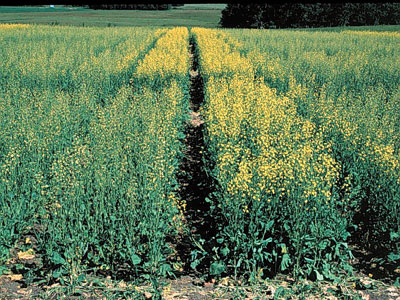
Features
Agronomy
Fertility and Nutrients
Sulphate S fertilizer more effective than elemental S
It is elementary, but not in favour of elemental sulphur (S). A four-year research trial conducted by Agriculture and Agri-Food Canada (AAFC) research scientist Dr. Sukhdev Malhi found that while elemental S fertilizer was better than no S fertilizer on deficient soils, spring-applied sulphate-S fertilizer produced the best canola yields.
February 24, 2010 By Bruce Barker
It is elementary, but not in favour of elemental sulphur (S). A four-year research trial conducted by Agriculture and Agri-Food Canada (AAFC) research scientist Dr. Sukhdev Malhi found that while elemental S fertilizer was better than no S fertilizer on deficient soils, spring-applied sulphate-S fertilizer produced the best canola yields.

|
|
| Even after four successive years of application, elemental-S fertilizer was not as good as sulphate-S fertilizer for correcting deficiencies in canola. (Photo courtesy of Agriculture and Agri-Food Canada) |
Malhi conducted the four-year canola experiment (1999 to 2002) on S-deficient soil near Tisdale in northeastern Saskatchewan. While elemental S fertilizer may cost less than sulphate-S fertilizers, their effectiveness and value depend on how quickly the S is oxidized to sulphate-S for plant uptake. Elemental S fertilizer is not plant-available, and must be converted to sulphate by microorganisms before canola can access the nutrient. “The question we wanted to answer was whether annual applications of elemental S provide similar seed yield in canola as an annual application of sulphate-S, and if so, how many years it would take,” says Malhi.
The rate of S oxidation increases with increasing temperature and moisture. Oxidation of elemental S to sulphate-S is also usually positively related to soil pH, organic matter content, nutrient-supplying power and microbial activity. Oxidation can be slower with higher clay content in the soil.
Malhi says that farming and fertilizer management practices that increase the oxidation rate of elemental S in soil include reducing particle size of the fertilizer product, using tillage to incorporate elemental S fertilizer into the soil to increase contact area between elemental S particles and soil micro-organisms, and application in advance of crop demand to allow oxidation to occur before plants require this element.
The S fertilizer treatments included granular types of two bentonite-elemental S fertilizers (ES-90 and ES-95), one sulphate-S (ammonium sulphate), one containing elemental S and sulphate-S (Agrium Plus), and a zero-S control.
The S fertilizers were surface-broadcast at 10 or 20 kg of S per hectare (nine to 18 lbs of S per acre) rates in the previous fall or in spring, and incorporated into the soil a few days prior to seeding in May. Canola plants in the zero-S control showed S deficiency in the growing season in all years.
Fall- better than spring-applied elemental S, but still not good enough
In the first year of the study, there was no significant increase in seed yield from the elemental S fertilizers. This could be attributed to the slow rate of S oxidation (conversion to plant-available sulphate-S form).
Fall-applied elemental S usually had greater seed yield and S uptake than the spring-applied elemental S in 2000, 2001 and 2002. “Elemental S fertilizers usually corrected S deficiency in canola and increased seed yields significantly over the zero-S control in the last three years of the study. But yield and S uptake were less than the sulphate-S fertilizer in most cases in 2000, in many cases in 2001 and in some cases in 2002, especially when the S fertilizers were applied in spring,” explains Malhi.
Furthermore, Malhi says the greater dispersion of elemental S particles from granular elemental S fertilizers was needed to enhance microbial oxidation to sulphate-S in soil, and this was considered to be the main requirement for increasing the short-term availability of S in elemental S fertilizers. He says this was verified in another trial where canola seed yield and nitrogen and S uptake with surface application of suspension and powder formulations of elemental S fertilizers were similar to sulphate-S fertilizer.
Additionally, Malhi says that the residual benefit of many successive annual elemental S fertilizer applications on soil S fertility was not apparently cumulative.

|
| Seed yield increase from various S fertilizers applied at two rates to canola near Tisdale in 2002.
|
Spring-applied sulphate-S best option
In all four years, sulphate-S fertilizer produced the highest seed yields. However, fall-applied ammonium sulphate produced or tended to produce lower seed yield and S uptake than spring-applied ammonium sulphate in some cases. “This is most likely attributed to over-winter loss of sulphate-S from the soil root zone,” says Malhi.
In summary, the results indicated that elemental S fertilizers were not effective in increasing canola yield and S uptake on the S-deficient soil in the first year of application. The elemental S fertilizers became effective in the second to fourth year, but seed yield and S uptake were still less than those obtained with sulphate-S fertilizer, particularly when the S fertilizers were applied in spring. “The findings suggest the need for research on best management practices to improve effectiveness of elemental S fertilizers,” says Malhi. “Currently, spring-applied sulphate-S fertilizer is the most effective way to correct S nutrient deficiencies in canola.”